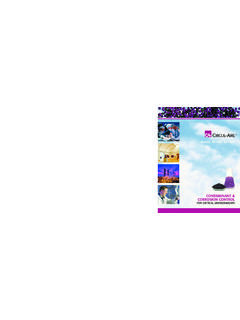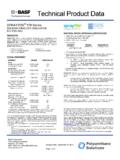Transcription of NIOSH Respirator Selection Logic
1 NIOSH Respirator Selection Logic 2004 Author: Nancy Bollinger, U. S. Department of Health and Human Services National Institute for Occupational Safety and Health October 2004i Centers for Disease Control and PreventionNIOSH Respirator Selection Logic Ordering Information To receive documents or other information about occupational safety and health topics, contact the National Institute for Occupational Safety and Health ( NIOSH ) at NIOSH Publications Dissemination 4676 Columbia Parkway Cincinnati, OH 45226-1998 Telephone: 1-800-35- NIOSH (1-800-356-4674) Fax: 1-513-533-8573 E-mail: visit the NIOSH Web site at This document is in the public domain and may be freely copied or reprinted.
2 _____ Disclaimer: Mention of any company, product, policy, or the inclusion of any reference does not constitute endorsement by NIOSH . DHHS ( NIOSH ) Publication No. 2005-100 ii Foreword The purpose of this Respirator Selection Logic (RSL) is to provide guidance to Respirator program administrators on Respirator Selection that incorporates the changes necessitated by the revisions to the Respirator use and certification regulations and changes in the National Institute for Occupational Safety and Health ( NIOSH ) policy. This RSL is not intended to be used for Selection of respirators for protection against infectious agents or for chemical, biological, radiological or nuclear (CBRN) agents of terrorism.
3 While respirators can provide appropriate protection against these agents, the information necessary to use the Selection Logic is generally not available for infectious disease or bioterrorism agents ( , exposure limits, airborne concentration). Similarly, CBRN terrorism events may involve chemicals that can quickly degrade Respirator materials or have extremely low toxic levels that are difficult to measure. In 1987, NIOSH published the NIOSH Respirator Decision Logic (RDL). Since then the Occupational Safety and Health Administration (OSHA) has promulgated a revision to their Respirator use regulation ( published on January 8, 1998), and NIOSH has promulgated the revised Respirator certification standard (42 CFR84 on June 8, 1995).
4 In addition, NIOSH has revised its carcinogen policy to recommend the complete range of respirators as determined by this Respirator Selection Logic for those carcinogens with quantitative recommended exposure limits (RELs). Thus, respirators can be consistently recommended regardless of whether a substance is a carcinogen or not. OSHA recently proposed a rule to establish assigned protection factors (APFs) for various classes of respirators (68FR34036 published on June 6, 2003). When the OSHA standard on APFs is finalized NIOSH intends to consider revisions to this RSL. NIOSH will also modify the certification program to assure that NIOSH certified respirators will be capable of providing the level of protection determined in the OSHA APF rulemaking.
5 NIOSH also intends to periodically update the RSL so that it reflects current OSHA requirements and NIOSH policy. Sincerely yours, John Howard, Director, National Institute for Occupational Safety and Health Centers for Disease Control and Prevention iii Acknowledgements The NIOSH Respirator Policy Group served as the internal reviewers for this document. Donald Campbell and Christopher Coffey made major contributions to this document through their extensive review and suggestions for revisions. NIOSH thanks Heinz Ahlers, Roland BerryAnn, Frank Hearl, Richard Metzler, Teresa Seitz, Douglas Trout and Ralph Zumwalde for their considerations and comments and Katie Musgrave for preparation of the document.
6 NIOSH would also like to thank the external reviewers for their comments. iv Table of Contents I. Background and II. Information and A. Criteria for Selecting B. Restrictions and Requirements for All Respirator III. Respirator Selection Logic Table 1. Particulate Table 2. Gas/Vapor Table 3. Combination Gas/Vapor & Particulate IV. Escape V. Additional Information on Hazards and Subparagraph 1: Oxygen-Deficient Subparagraph 2: Exposure Subparagraph 3: Immediately Dangerous to Life or Health (IDLH)..20 Subparagraph 4: Eye VI. Glossary of Respiratory Protection Appendix: NIOSH Policy v I.
7 Background and Purpose The purpose of this Respirator Selection Logic (RSL) is to provide a process that Respirator program administrators can use to select appropriate respirators for the protection of workers in specific workplaces. It is not intended to be used for Selection of respirators for protection against infectious agents or chemical, biological, radiological or nuclear (CBRN) exposures associated with terrorism events.* This RSL contains a series of questions regarding situations which may require the use of respirators. (See Respirator Selection Logic Sequence, page 5.) In answering these questions, the user of this Selection Logic is assisted in identifying specific classes of respirators, applicable restrictions, and the appropriate Respirator Selection table to use.
8 When using one of the tables to identify a suitable class of respirators, the user must keep in mind the restrictions identified in the question section of this Respirator Selection Logic . This RSL identifies the criteria necessary to determine the classes of respirators that will provide the minimum acceptable degree of protection for a chemical at a given concentration. Classes of respirators offering greater protection can usually be used in place of the minimum acceptable class of respirators. Respirator classes are consistent with Respirator certification groupings as specified in 42 CFR 84. The recommendations in this RSL are based primarily on the physical, chemical, and toxicologic properties of the contaminant and on the limitations of each class of Respirator , including filtration efficiency, air supply capability, and face seal characteristics and leakage.
9 Thus, this Selection Logic is limited to identifying classes of acceptable respirators, rather than individual Respirator models. After various classes of respirators are identified as being suitable for a given situation, an evaluation is made of other factors of the particular work environment ( , job, task, temperature, mobility, etc.) so that the most appropriate Respirator model within the recommended classes can be chosen. In some situations, the Selection of a Respirator classified as providing a higher level of protection may be advisable. The assigned protection factors (APFs) used in this Respirator Selection Logic were based on quantitative fit factor data developed by Los Alamos National Laboratories under contract to NIOSH and on field and laboratory data gathered by NIOSH and others.
10 A Notice of Proposed Rulemaking on Assigned Protection Factors was published by OSHA on June 6, 2003. When this regulation is finalized, NIOSH will consider the new standard and revise the RSL as necessary. NIOSH will also modify its certification * Note: Selection of respirators for infectious disease and terrorism-related exposures requires consideration of additional factors in addition to the traditional exposure assessment approaches described in this guidance. See the NIOSH Respirator topic page for additional information and guidance on particular infectious disease and terrorism issues.











